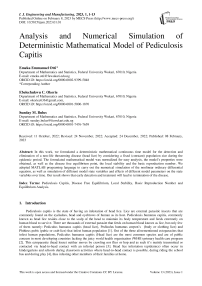Analysis and Numerical Simulation of Deterministic Mathematical Model of Pediculosis Capitis
Автор: Emeka Emmanuel Otti, Ebelechukwu C. Okorie, Sunday M. Bulus
Журнал: International Journal of Engineering and Manufacturing @ijem
Статья в выпуске: 1 vol.13, 2023 года.
Бесплатный доступ
In this work, we formulated a deterministic mathematical continuous time model for the detection and elimination of a non-life threatening disease (head lice) by considering a fixed (constant) population size during the epidemic period. The formulated mathematical model was normalized for easy analysis, the model’s properties were obtained, as well as the disease free equilibrium point, the local stability and the basic reproduction number. We adopted MATLAB programing language to carry out the numerical simulation of the nonlinear ordinary differential equation, as well as simulation of different model state variables and effects of different model parameters on the state variables over time. Our result shows that early detection and treatment will lead to termination of the disease.
Pediculosis Capitis, Disease Free Equilibrium, Local Stability, Basic Reproduction Number and Equilibrium Analysis
Короткий адрес: https://sciup.org/15018604
IDR: 15018604 | DOI: 10.5815/ijem.2023.01.01
Список литературы Analysis and Numerical Simulation of Deterministic Mathematical Model of Pediculosis Capitis
- Gary LD, Robert S. Arthropod bites and infestations. In: Behrman RE, Kliegman RM, Jenson HB, (editors). Nelson Textbook of Pediatrics. 17th ed. Pennsylvania: Saunders; 2004; 2238-42.
- Hadeel T. Al-Barrak. (2021) Prevalence of Head Lice (Pediculus humanus capitis) among Primary School Children in Baghdad Suburbs. Journal of, 21(1); 280-284.
- Meister, L., Ochsendorf, F., 2016. Head lice: Epidemiology, biology, diagnosis, and treatment. Dtsch Arztebl Int 113, 763.
- B.A.N Okoh and E.A.D Alikor. (2013) Pervalence of Head Lice Infestation in Primary School Children in Port Harcourt. East African Medical Journal, 90(8); 269 – 274.
- American Academy of Pediatrics. Pediculosis Capitis (Head Lice). In: Pickering LK, Baker CJ, Kimberlin DW, Long SS, eds. Red Book: 2012 Report of the Committee on Infectious Diseases. Elk Grove Village, IL: American Academy of Pediatrics; 2012: 543-546.
- Stephen, E. and N. Nyerere. (2015). A Mathematical Model for the Dynamics of Cholera with Control Measures. Applied and Computational Mathematics. Vol.4, No.2, pp.53-63. doi:10.11648/j.acm.20150402.14.
- Feldmeier, H., 2012. Pediculosis capitis: new insights into epidemiology, diagnosis and treatment. Eur. J. Clin. Microbiol. Infect. Dis. 31, 2105–2110.
- Speare R, Buettner PG. Head lice in pupils of a primary school in Australia and implications for control. Int J Dermatol 1999; 38: 285-90.
- Ebomoyi E. Pediculosis capitis among primary school children in urban and rural areas of Kwara State, Nigeria. J Sch Health 1988; 58:101-3.
- Olaitan OL. Head lice infestation among primary school children in Ibadan, Oyo State, Nigeria. AJES 2006; 4:134–40.
- Jinadu MK. Pediculosis humanus capitis among primary school children in lie-ife, Nigeria. J R Soc Promot Health 1985; 105: 25-7
- Ogunrinade AF, Oyejide CO. Pediculosis capitis among rural and urban school children in Nigeria. Trans R Soc Trop Med Hyg 1984; 78:590-2.
- Revie CW, Robbins C, Gettinby G, Kelly L, Treasurer JW (2005). A mathematical model of the growth of sea lice, lepeophtheirus salmonis, populations on farmed atlantic salmon, salmo salar l., in scotland and its use in the assessment of treatment strategies. Journal of Fish Diseases 28: 603–613.
- Beugnet F, Chalvet-Monfray K, Sabatier P (1998) Using of a mathematical model to study the control measures of the cattle tick boophilus micropilus populations in new caledonia. Veterinary parasitology 77: 277–288.
- Beugnet F, Porphyre T, Sabatier P, Chalvet-Monfray K (2004) Use of a mathematical model to study the dynamics of ctenocephalide felis populations in the home environment and the impact of various control measures. Parasite 11:387–399.
- Takano-Lee M, Yoon KS, Edman JD, Mullens B, Clark JM (2003) In vivo and in vitro rearing of pediculus humanus capitis (anoplura: Pediculidae). Journal of Medical Entomology 40: 628–635.
- Patricia Stone; HildeWilkinson-Herbots and Valerie Isham (2008). A stochastic model for head lice infections. J. Math. Biol. 56:743–763
- Kermack, W.O and McKendrick, A.G. (1927). A contribution to the mathematical theory of epidemics. Proceedings of the Royal Society of London. Series A, 115(772), 700-721.
- Weiss, G., Dishon, M.: On the asymptotic behaviour of the stochastic and deterministic models of an epidemic. Math. Biosci. 11, 261–265 (1971).
- Korobeinikov A, Wake GC (2002). Lyapunov function and global stability for SIR, SIRS and SIS epidemiological models, Appl. Math. Lett. 15:955-960.


